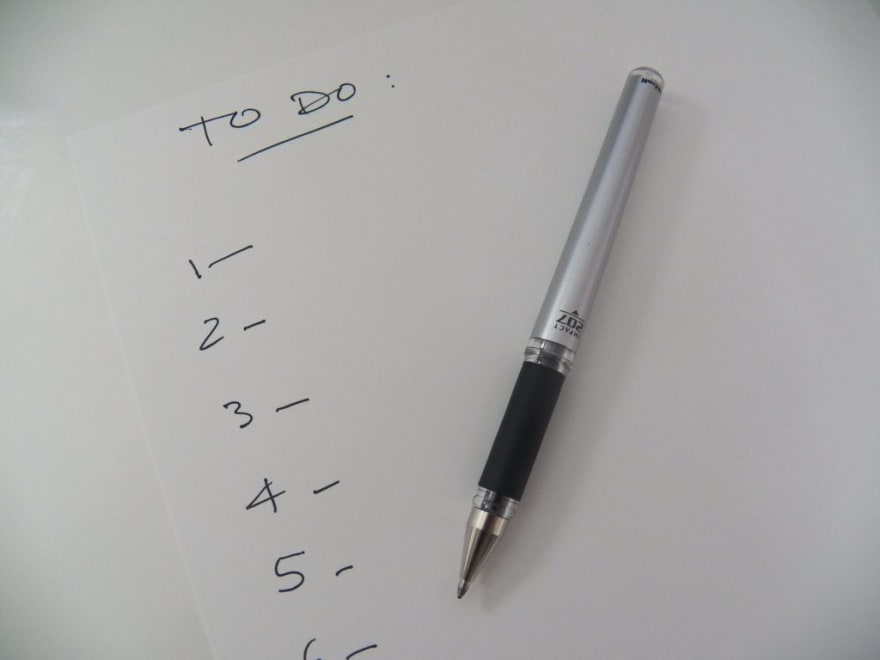In the previous article of this two-part series Hacking Your Life with Task Types. I discussed the four quadrants of the Eisenhower Matrix and how to use it to determine a task's Importance and Urgency. In this article, I will introduce you to a few task management strategies that I've learned and implemented to ensure I'm doing what is most important to me. These strategies are the
- Capture Sheet
- Chunking
- Life Categories.
Capture Sheet
The capture sheet is much like a to-do list, but expands it, allowing it to be used as a base for planning. Most to-do lists are typically short-termed or project-focused. They are things that need to be done soon and often are filled with urgent tasks. A capture sheet will contain all tasks, plans, and ideas for all your projects and timelines.
Why is having a capture sheet important?
Capture sheets keep us from forgetting tasks that we might think are important to accomplish in the future. It doesn't matter how good of a memory we think we have, we can only juggle so many thoughts at once. Keeping everything in our heads might cause us to forget about an important but less urgent task.
Keeping everything in our heads also puts unneeded stress on our brain, which uses energy. This impacts our capacity to think clearly and concentrate. The first time I did a capture sheet a sense of euphoria came over me. It was like a weight was lifted and I could be more present with the immediate tasks.
Capture sheets give us a platform for organizing, planning, and chunking our tasks.
What is a capture sheet?
- A dumping ground: There are no bad thoughts or tasks on a capture sheet. All ideas are valid, because you thought of it.
- Impermanent: Because the capture sheet is an idea dumping ground, it can be thrown away or altered. Expect to have many iterations of capture sheets, either weekly, monthly, or even versions of the same sheet.
- Easy to access: The purpose of the capture sheet is to get the idea or task out of your head as quickly as possible. Phone apps are generally a go-to for easy access, but personally I use a journal that I keep close by. A journal allows me to easily see many items and allows me to write notes, timestamps, levels of importance, and categories. Sometime I'll use my phone to capture a thought if my journal is not nearby and I transcribe the idea to my journal when I get back home.
- Confidence booster: Keeping old capture sheets and reviewing them over time allows us to see how far we come. It tracks our thoughts and shows us how we've evolved as we worked through important tasks.
- Satisfying: Let's face it, physically scratching items off a list is satisfying.
Chunking
Now that we have a list of items we need a way not to feel overwhelmed with all we have to do. Chunking is a great way to handle the overwhelm. Chunking allows us to group tasks into bite-size pieces that we can plan and work with.
How to Chunk
There are many ways to chunk tasks that will work differently for different people, situations, and projects. Sometimes chunking can be a combination of approaches, and the same task can exist in different chunks. The important thing to remember when chunking is to keep it as simple as possible. Here a few ways to chunk tasks.
- Project: Chunking tasks by the project or goal is the most common way to get started. This allows us to see what needs to be done in order to reach an objective. Once tasks are grouped by the project they can be ordered in sequence, importance, or urgency. A trick I employ when organizing a project chunk is to say to myself "What task can I do that will make all other tasks easier or irrelevant." This will help you make the most out of your precious time.
- Importance: Sometimes chunking tasks by importance is a good way to see what task will be the most impactful on your life. Often this is a great way to organize tasks across multiple projects in order to plan your immediate schedule.
- Urgency: This is a consequence-based way to look at tasks. It is also a way to organize tasks across multiple projects.
- Life Categories: Life categories are areas or your life that are important to you and typically consists of multiple projects and goals. They can be thought of as a larger chunk of goals. Life categories will be discussed later in this article.
Up and Down Chunking
Up and down chunking is a way of organizing your tasks to make them detailed enough to accomplish without being overwhelmed. After grouping tasks on a project level, you may find that not all the tasks seem to be at the same level logically. For example, planning a trip to a foreign country. You may end up with a list of tasks like
- Buy tickets
- Buy travel clothes
- Get passport renewed
- Research trip
- Buy guidebooks
- Ask friends about the location
- Research airfare
- Plan activities
- Book hotel
In the above list, there are a bunch of tasks that appear at different levels of the project. Items 5, 6, 7, and 8 can be seen as sub-tasks of "researching the trip" (item 4). Up chunking, these 4 items into a larger chunk make organizing the project easier. If we look at this project at larger chunks we might end up with
- Research Trip
- Book trip
- Prepare for travel
- Travel
This list of 4 items is easier to manage over the life of this travel project. Four items are less overwhelming than 9+ items. The fact that it is less overwhelming helps ensure that we will follow through with this project. As we begin to work through these four larger chunks, we can break each large chunk into small chunks to plan over the course of a day(s) or week(s).
Life Categories
Life categories is the idea that our lives are made up of many parts or categories that need to be managed. Many of these categories such as finances, career, and family, maybe obvious, but often we are not aware of all of our life categories. Often these unknown categories take the shape of multiple related goals. The fulfillment of these goals brings us a feeling of peace, joy, accomplishment, and fulfillment. Being able to identify them and plan meaningful (important) activities is the key to mitigating burnout and frustration.
For example, if you are solely focusing on career and finances and begin to feel burnt out, it might be because you may not be honoring your need for relationships or physical health. Often we can be so locked into a particular goal that we deem everything else as unimportant. So we grind. This causes us to obsess and burnout. If we step back and take care of other needs we find the obtaining the main goal will become easier and more enjoyable.
So how could this manifest? In the previous article I mentioned making time for important, non-urgent tasks. Sometimes we label a task as not important, such as playing a board game or going for a swim, but in actuality, it is important to us, because it brings us joy and fulfillment.
Categories
The following list is some suggestions for categories to consider. For simplicity's sake, try and keep the number of categories small and add more as you master them or feel them evolve. Remember to up chunking to make them manageable.
- Finance
- Career/Mission
- Health/Fitness
- Personal Growth
- Recreation/Fun
- Friends/Social
- Family
- Romance
- Contribution/Spiritual
Summary
How we manage tasks can lead to a more fulfilled and productive life. Especially if we take a holistic approach to how we manage the tasks and our life. Utilizing the Einshower Matrix, Capture Sheets, Chunking, and Life Categories are a few great approaches. However, there are many more strategies, and often how we use and approach these strategies may change with time.









Top comments (0)